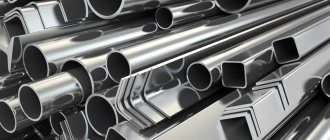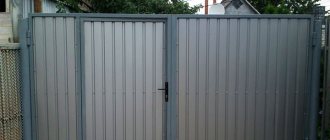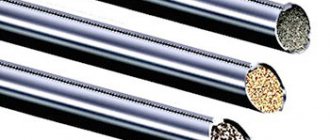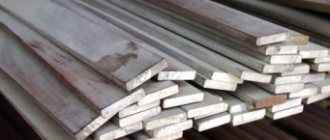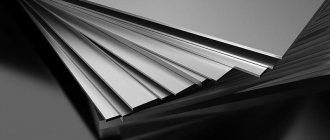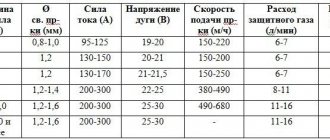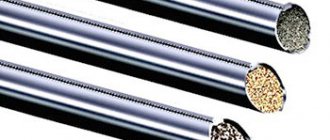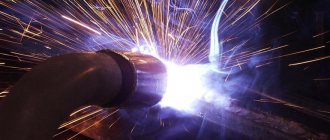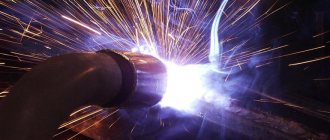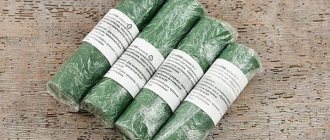Home > Articles > Marking of rolled metal products
Marking of rolled metal products is regulated by GOST 7566-94. However, during the construction process, not everyone wants to understand GOST standards. In addition, all markings, for example, of rebar or steel angles, are listed in the price list. And then you saw strange abbreviations there. To understand which rolled metal product is suitable in each specific case, it is enough to know the rules for reading labeling symbols.
For example, to fence an area with a fence made of corrugated sheets, you must purchase a metal profile of a certain marking. This type of rolled metal product is marked in the form of a set of numbers and letters: for example, 0.7x2000x3000 C9. This combination of characters carries the following information:
- 0.7 mm – thickness;
- 2000 mm – width;
- 3000 mm – length.
Now we can conclude that the profile sheet will have a size of 2 * 3 m and a thickness of 7 mm. The letter indicates the application: C – wall, N – roofing, and NS – mixed type, which is used for various purposes. Any metal warehouse is required to advise you on this matter.
However, you must figure it out yourself so that when purchasing products in the future, you can check whether the appropriate rolled metal alloy was delivered and whether it is marked according to accepted standards. Rolled metal is marked depending on its supply to the market: internal or external.
Marking of rolled metal for the domestic market
Depending on the packaging, the marking may be applied to the product itself or to the label. If the rolled metal product is large enough and not packaged, markings are applied specifically to it. And if the products are supplied in packages (packs, rolls, skeins), then the markings will be applied to the labels.
Metal products are marked in various ways:
- Branding (manual or machine);
- Electrographing;
- Colored varnish;
- Indelible paint;
- Labels made of waterproof film.
In order for the marking of rolled metal without packaging to be easily considered during purchase and shipment, it is applied no further than 2 m from the edge of each product or on the outside on the coil of the roll. With automatic marking, it can be made further from the edge, end or edge no longer than 500 mm.
Labels are hung in the following order:
- skein / 1 tag;
- roll / 1 label;
- pack / 2 labels;
- bundle / 1 tag for 1 of the skeins and 1 for the binding;
- ream / 1 label per 1 of rolls and 1 per ream of rolls.
Types of channels
The most popular type of assortment is channel.
Channel
This is explained by high strength indicators, good weldability, low weight with significant load-bearing capacity. It is used on construction sites for floors, in the manufacture of metal structures such as trusses, columns and reinforced concrete products. For all its advantages, the channel has an affordable price.
Manufacturers offer profiles of various sizes and types. The directory of rolled metal products contains a large list of several dozen items that differ in type, size, symbol, and marking.
In the construction industry, the use of channels helps to strengthen the structure, increase rigidity and performance characteristics. This is explained by the fact that concrete itself is resistant only to compressive stresses. The channel remains stable under the influence of bending load, pressure in the longitudinal and transverse plane.
The main method of obtaining a profile is hot rolling. The raw materials used are blanks produced by forging or continuous casting. The material for production is structural steel grade St 3 or 09G2S, carbon construction steel C 235, C 245.
MetalPromContinent
Labels for marking rolled metal products
Labels must be firmly attached and easily visible. The material used for manufacturing is reliable and wear-resistant, so that during transportation and unloading they are not damaged or come off. Sometimes, for safety, labels are placed in special pockets.
When packing rolled metal into bundles, markings are placed in 2 places:
- the top sheet or strip of each bundle;
- marking card or label attached to the pack's binding.
When auto-marking thick and strip metal products, the side edge of the top sheet or strip of each bundle can be branded. On the sheets, the marking area is outlined using paint, bitumen or colored varnish. If the customer so requests, the markings are highlighted in a contrasting color, and the labels are perforated 10 mm from the edge for fastening with wire on all types of metal products.
Marking of rolled products in packs or without packaging if the size exceeds 3 cm and thickness exceeds 4 mm must contain:
- Name of the company;
- steel grade;
- Heat number;
- Batch number;
- all sizes.
The marking on the label, the end of the roll or the edge of the metal sheet contains the company name, steel grade, heat number, batch number, all sizes, group or strength class, weight. For reliability and clarity of marking, the label can be metal, wood, plastic or moisture-resistant film; their area must be at least 24 cm2, and the letters must have a height of 5-20 mm and a width of 3-12 mm.
Sometimes it is allowed to deviate from the specified font size when marking with paint. It can reach 1 m in height and 7 cm in width; on rods with a diameter of less than 6 cm and strips with a width of less than 5 cm it can be reduced to 2-4 mm.
The consumer may request additional marking with colored paint; for rolled metal made of mild steel, marking with a longitudinal stripe; for rolled metal made of mild steel, a transverse stripe; marking can occur at a specified font depth. Transport marking is regulated by GOST 14192.
Symbols of the main elements in grades of metals and alloys
| Element | Symbol | Symbols of alloying elements | Density, g/cm3 |
| Nitrogen | N | A | 1,25 |
| Aluminum | A.I. | YU | 2,698 |
| Barium | Ba | — | 3,61 |
| Beryllium | Be | L | 1,86 |
| Bor | B | R | 2,33 |
| Vanadium | V | F | 6,12 |
| Bismuth | Bi | In and | 9,79 |
| Tungsten | W | IN | 19,27 |
| Gadolinium | Gg | — | 7,886 |
| Gallium | Ga | Gl | 5,91 |
| Hafnium | Hf | — | 13,36 |
| Germanium | Ge | — | 19,3 |
| Holmium | Ho | — | 8,799 |
| Dysprosium | Dy | — | 8,559 |
| Europium | Eu | — | 5,24 |
| Iron | Fe | — | 7,87 |
| Gold | Au | — | 19,32 |
| Indium | In | — | 7,3 |
| Iridium | Ir | AND | 22,4 |
| Ytterbium | Yb | — | 6,959 |
| Yttrium | Y | — | 4,472 |
| Cadmium | Cd | Kd | 8,642 |
| Cobalt | Co | TO | 8,85 |
| Silicon | Si | C | 2,326 |
| Lanthanum | La | — | 6,162 |
| Lithium | Li | — | 0,534 |
| Lutetium | Lu | — | 9,849 |
| Magnesium | Mg | — | 1,741 |
| Manganese | Mn | G | 7,43 |
| Copper | Cu | D | 8,96 |
| Molybdenum | Mo | M | 10,22 |
| Neodymium | Nd | — | 7,007 |
| Nickel | Ni | N | 8,91 |
| Niobium | Nb | B | 8,55 |
| Tin | Sn | — | 7,29 |
| Osmium | Os | — | 22,48 |
| Palladium | Pd | — | 12,1 |
| Platinum | Pt | — | 21 |
| Praseodymium | Pr | — | 6,769 |
| Rhenium | Re | — | 21,04 |
| Rhodium | Rh | — | 12,5 |
| Mercury | Hg | — | 13,5 |
| Ruthenium | Ru | 12,3 | |
| Samarium | Sm | — | 7,53 |
| Lead | Pb | — | 11,337 |
| Selenium | Se | E | 4,792 |
| Silver | Ag | — | 10,5 |
| Scandium | Sc | — | 2,99 |
| Antimony | Sb | — | 6,69 |
| Thallium | Tl | — | 11,85 |
| Tantalum | Ta | — | 16,6 |
| Tellurium | Te | — | 6,25 |
| Terbium | Tb | — | 8,253 |
| Titanium | Ti | T | 4,505 |
| Thulium | Tu | — | 9,318 |
| Carbon | C | U | 2,2 |
| Phosphorus | P | P | 1,83 |
| Chromium | Cr | X | 7,2 |
| Cerium | Ce | — | 6,768 |
| Zinc | Zn | — | 7,13 |
| Zirconium | Zr | C | 6,5 |
| Erbium | Er | — | 9,062 |
Marking of rolled metal for the foreign market
Rolled metal products supplied abroad are marked in Russian when transported to SMGS countries, and in English for other foreign countries.
Marking can be applied to:
- 2 ends;
- one longitudinal side (if it is impossible to apply to the ends);
- longitudinal side and end (rolled sheets in packages);
- top sheet of the pack (if there is packaging);
- each sheet (rolled sheet metal without packaging);
- marking card no less than 200x290 mm;
- steel label for export (if it is not technically possible to apply markings to the marking card or the rolled metal itself).
Labels are hung in the following order: one label per pack up to 6 m, coil, roll, wire rod; two labels are hung on a pack larger than 6 m, a bunch of skeins, a stack of rolls. The standards for labels for export differ from the requirements for labels that mark steel products for domestic sale.
Export labels must have a size of at least 80x120 mm and an aspect ratio of 1/1.5 and be made of tinplate, galvanized thin-sheet anti-corrosion metal, moisture-resistant film, which is applied to a solid metal base or some other dense material.
The export label must contain the following information about the metal product: name of the manufacturer's company, exporter's company, contract specification, country of destination, all dimensions, steel grade, group and strength class, heat and batch number, net and gross weight in kg, place of batch fraction.
Nomenclature of the manual
The main assortment includes:
- corner is equal and unequal;
- fittings;
- steel circle;
- channel;
- channel (bent);
- Sheet steel;
- pipes;
- seamless and electric-welded pipes;
- profile pipes (rectangular and square);
- I-beam;
- square and hexagon.
The range of rolled metal products is classified into two directions: black and stainless steel. The division occurs in accordance with the type of material used for manufacturing.
According to the production method, a distinction is made between cold-rolled and hot-rolled steel, bent from sheet material.
Hot-rolled profiles are made on special rolling mills, through the profile rolls of which a hot billet is passed under pressure. Rolling mills are included in process equipment lines that are several hundred meters long.
The hot rolling method is used to produce thick sheets, circles, angles, channels, I-beams, and thick-walled pipes.
The range of cold-formed profiles is produced by bending on special profile bending machines. This group includes bent angles, channels, and special profiles.
Hot-rolled profiles have greater strength and resistance to various types of loads than cold-rolled or bent sections.
Types of profile
The nomenclature is represented by the following profile types:
- hot rolled according to GOST 8240–89;
- special purpose according to GOST 19425–74;
- bent equal flange according to GOST 8278–75;
- bent unequal flange according to GOST 8281–80;
- Available in measured lengths from 2 to 12 meters.
The assortment is necessary for the construction of interfloor slabs, bridge spans, and roofing at production facilities. In architectural construction, channel bars are used to strengthen and reinforce walls. It is indispensable for the reconstruction of construction sites and installation of partitions.
In addition to the construction industry, the profile is in demand in the carriage building, many branches of mechanical engineering, shipbuilding and the automotive industry.
The profile is widely used in mechanical engineering
All profile sizes are standardized and comply with GOST:
- h – channel height;
- b – shelf width;
- s – profile wall thickness;
- t – flange thickness;
- R – radius of internal conjugation;
- r – radius of the flange rounding.
Channels with a slope should have a bevel of internal edges of 4–10%.
